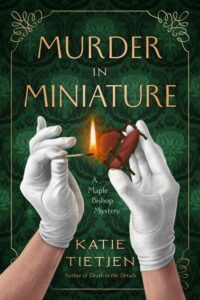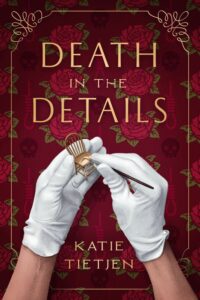
I was a huge fan of Katie Tietjen’s first novel, Death in the Details, which follows war widow Maple Bishop just after the war has ended. Maple is living in a tiny Vermont town and, though she’s a trained lawyer, ends up piecing together a living selling the dollhouses she creates. She also makes “nutshells,” tiny recreations of crime scenes. The nutshells are based on the work of Frances Glessner Lee, the mother of crime scene investigation. By book two, Murder in Miniature, Maple has earned the respect of the police in town and is now an official consultant. The books are charming, thoughtful, and fascinating. Katie was nice enough to answer a few questions about her books.
Q: I always think it’s difficult for a writer to follow up an origin story like the one in your first book, where you describe Maple’s circumstances and her particular qualities. Was this a challenge for you when you sat down to write this second book?
A: Actually, no! I found that the second book came together more easily than the first one because I already knew most of the main characters. I also knew that Maple would be feeling restless at the start of book two; on the surface, she seems to have solved the biggest problem plaguing her in Death in the Details (her finances), but underneath, she’s still not really satisfied personally or professionally.
 Q: At a recent book club, one of our members mentioned she found Maple “neurodivergent” which I guess is true, though I didn’t think about it when I was reading either book. What was your thought when you created Maple?
Q: At a recent book club, one of our members mentioned she found Maple “neurodivergent” which I guess is true, though I didn’t think about it when I was reading either book. What was your thought when you created Maple?
A: I love Maple’s brain. I didn’t set out to create her to fit any particular diagnostic profile; her personality just emerged as I wrote. I also enjoy her lack of filter. It gets her in trouble sometimes but also is kind of her best asset. You always know where you stand with Maple.
Q: I really like the time period and setting, which is unusual. Why set your books just post war? What called to you about that time?
A: Like many readers, I’m a big fan of WWII-era historical fiction. However, I haven’t read too much that is set immediately after the war. I think the time period suits my series because Maple is picking up the pieces of her own life and starting over on a personal level while the whole world pretty much has to do the same.
Q: In this book Maple creates some scenes of the fire that is the murder scene in the book. Did you base this on one of Frances Lee’s real creations? How about the way she tests the fire on the nutshells she creates?
A: The Nutshell that inspired the plot of Murder in Miniature is called “Burned Cabin” and depicts pretty much the same scene Maple, Kenny, and Sheriff Scott find when they arrive at the scene. To my knowledge, Frances Glessner Lee didn’t test the fire the way Maple does in this book; that came from my imagination as I was thinking of ways the Nutshell could be central to the plot in a different way than the one she made in the first book was.
Q: You also take Maple out of rural Vermont back to her childhood home of Boston, where she lost her brother. How important was it to you to resolve some of the issues Maple has with her brother’s death?
A: It was really important to me. As I was writing the first book, Jamie kept coming up in my thoughts and making his way onto the page; that’s how I knew he was so important to Maple. I like the idea of the detective character who solves other people’s murders, but is haunted by the mysterious unsolved death of someone they care about (Harry Bosch and his mother, for example). I wanted Maple’s emotional arc to center around Jamie in this book.
Q: How about the police scene in Boston? In this book you fold in some more high powered crimes – and criminals – than in the first novel, and part of the focus is a busy Boston police station. Can you talk about that a bit?
 A: I knew Maple would have to return to the place where she grew up, and in order to force her to go back–because she probably wouldn’t have chosen to do so on her own–I knew the primary mystery in the book would have to lead her there. Then, she’d have the opportunity to also delve into the circumstances around her brother’s death. I also really liked the idea of plopping Maple and Kenny into an environment very different from their small town and watching them struggle with that contrast.
A: I knew Maple would have to return to the place where she grew up, and in order to force her to go back–because she probably wouldn’t have chosen to do so on her own–I knew the primary mystery in the book would have to lead her there. Then, she’d have the opportunity to also delve into the circumstances around her brother’s death. I also really liked the idea of plopping Maple and Kenny into an environment very different from their small town and watching them struggle with that contrast.
Q: You take on some present-day issues in your books – sexism and racism – and manage to make those issues of the period, not anachronistic. Maple is a trained lawyer, for example, though she doesn’t practice. Can you talk about the sexism she encounters, and how many female lawyers would there have been in post WWII Boston?
A: More than there were in Elderberry, but still not many! Maple resents the fact that she can’t get hired as a lawyer, but in this book her two closest colleagues (both men) really value her professional opinions. It was important to me to show that as well as the frustrations and obstacles she faced.
Q: The mystery plot line is well crafted and pretty tricky. What helped you to learn about plotting a solid mystery? Who were your influences?
A: Thank you! I love Michael Connelly and Jacqueline Winspear, who both weave mysteries with a lot of heart behind them. In terms of craft, I found two books especially helpful: Save the Cat! Writes a Novel by Jessica Brody and Story Genius by Lisa Cron. They both explore the psychology behind storytelling in fascinating ways.
Q: Can you name a book you found transformational, either as a reader or a writer?
A: I’m currently reading We Begin at the End by Chris Whitaker and am absolutely blown away by his writing. He had me emotionally invested in all the characters from the moment they appeared on the page, and now I’m wringing my hands and worrying about them. I’m planning to read everything this author writes!
Q: What’s next for Maple? What can readers look forward to in book 3?
A: Definitely more dead bodies and miniatures! Some consistent feedback I have gotten from the first two books is that readers really want to see more of Maple actually doing the work of crafting the nutshells. You can also count on the rich cast of secondary characters continuing to play important roles and on further antics from Mack the cat and Frank the dachshund. Don’t worry, though–I will never hurt the pets!
Thanks Katie!
*********
Katie Tietjen is an award-winning writer, teacher, and school librarian. A Frances Glessner Lee enthusiast, she’s traveled thousands of miles to visit her homes, see her nutshells, and even attend her birthday party. Katie lives in New England with her husband and two sons. The Mary Higgins Clark Award-nominated Death in the Details is her first novel; the next book in the Maple Bishop series, Murder in Miniature, is slated for publication in September 2025.